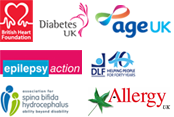Diabetic Retinopathy
Most people with diabetes will develop some form of eye disease which can harm sight or cause blindness. Diabetic retinopathy is the most common cause of blindness amongst people between the ages of 16 to 64 in Britain. Keeping blood glucose levels as normal as possible (4-7mmol/l before meals and not more than 10mmol/l after meals) will reduce the chances of developing retinopathy by 76%.
What is retinopathy?
Diabetic retinopathy affects the blood vessels supplying the retina. The network of blood vessels that supply the retina can become blocked and damaged or grow irregularly which affects the visual images received by the retina, and if left untreated can result in permanent vision loss.
Retinopathy is a progressive condition and develops over time. Normally there are no obvious symptoms until it is advanced.
Who gets retinopathy?
Whether diabetes is treated with insulin, tablets, or diet alone retinopathy can affect anyone with diabetes. Persistently high levels of blood glucose, together with high blood pressure and high cholesterol, are the main cause of retinopathy. Nearly 20% of people with type 1 diabetes have a degree of retinopathy when they are first diagnosed because their diabetes may have been present for months/years before being diagnosed, and their glucose levels will have been significantly higher than normal for a long time.
Treatment for retinopathy
Retinopathy is usually treated by laser, and is very successful if it is caught early. Laser beams are used to destroy the damaged parts of the retina, stopping the growth of new abnormal blood vessels and preventing further damage.
Retinopathy can be managed through keeping glucose levels close to normal and regular eye checks, and early detection is the key to successful treatment.








